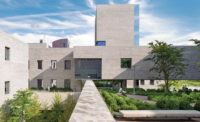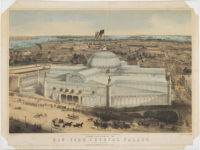Brooklyn, New York
In his final days of office last year, former New York Mayor Michael Bloomberg cut the ribbon on the Samuel J. and Ethel LeFrak Center, a Tod Williams Billie Tsien–designed skating facility in Brooklyn's Prospect Park. Standing nearby, the architects waited for a crowd of invited children to dash onto the ice, but when the rink's gate finally opened, “You saw one little kid creeping out slowly, holding like mad to the edge of the wall, and then the next one and the next one,” remembers Tsien. “It was like a line of little ants.”
They originally planned the site to stage a formal moment, as they famously did by the water's-edge at Bethesda Terrace in Manhattan's Central Park. A carriage concourse terminated near the shore of Prospect Park's lake, where visitors could listen to performances by musicians stationed across a small channel on Music Island. In a 1961 overhaul, the channel was filled in to make way for a shedlike ice-skating facility and—in typical Robert Moses–era fashion—a parking lot replaced the carriageway.
Williams and Tsien worked with landscape architect Christian Zimmerman, vice president of capital and landscape management for the nonprofit Prospect Park Alliance (PPA), to restore if not replicate Olmsted and Vaux's vision, reviving the green space while retaining the site's role as a gathering place. The center's two rinks, an uncovered ellipse and a canopied hockey rink, are both open for public skating in the winter, and the hockey rink will host roller-skating in the summer, filling a void left by the closure of the Empire Roller Skating Center, an institution in the nearby Crown Heights neighborhood. (The new plan even revives Music Island—but replaces the once awkwardly marooned musicians with a wildlife habitat.) “I feel that this is the most important piece we've ever done, because it's the most public,” says Tsien. “It's the one that everybody can go to.”
Only visitors who want to skate need to pay; anyone else may walk freely through the facility, which has no fences (it has nearly doubled the number of public restrooms in the park). The overall project was realized through a public-private partnership between the PPA and the New York City Parks Department that persevered through years of bureaucratic snags and financial challenges.
When Lakeside opened in December, the public was introduced to two single-story rectangular buildings topped by roof terraces that bound the rinks in an L-shaped plan. One building contains an ice-making plant, mechanical facilities, a café, and storage areas, and the other houses skate rental, lockers, a shop, and offices. Vegetated berms conceal these structures from the park's main path—visitors can be on top of the center and almost unaware of the crowds twirling below to a soundtrack of pop songs. At a serendipitous (and unplanned) point while crossing a bronze and reclaimed-teak footbridge connecting the terraces, the top of the Verrazano Bridge comes into view in the distance. “It's not unlike what Olmsted and Vaux had designed,” says Zimmerman. “They didn't want you to see everything all at once. They wanted that illusory feel that things disappear and come back and disappear again.”
To achieve this effect, the architecture is deferential to the park's landscape and historical character. While the hockey rink's 25,000-square-foot canopy—its rooftop planted with sedum—appears massive from below, it barely registers from the park's East Drive, and will be even less noticeable as the landscape matures. The 10 granite-clad structural steel columns that support the canopy are irregularly spaced to leave corners open, giving skaters unobstructed sightlines to the lake. Everywhere, Williams and Tsien echo the park's original architecture with granite, bluestone, and bronze, among other materials.
Their bolder gestures are appropriately playful. The midnight-blue stucco ceiling of the hockey rink canopy is as striking in person as it is in the Instagram photos frequently posted by skaters, though carved silver markings styled after blade marks on ice could look kitschy in a few years next to the more timeless lighting, which resembles a starry sky. At times, the old and new clash, such as when the rink's contemporary luminaires come into view from the neighboring esplanade, with its old-fashioned lampposts.
Ultimately, the structures aren't the focus. “The experience of being there is the point,” says Tsien. Among the project's achievements are the varied opportunities it creates for viewing. Onlookers can watch the action from the terrace above or from several comfortable rinkside perspectives.
On a sunny day in early January, spectators included parents of skating children and park visitors who happened upon the new rinks, all watching a stream of people whirl around the ice. With the wrongs of previous decades erased, the site has become a busy center of activity stitched into the fabric of the park with a deftness worthy of Olmsted and Vaux's masterpiece.
PeopleFormal name of building: Location: Owner: City of New York, Department of Parks and Recreation Client: Prospect Park Alliance Architect: Personnel in architect's firm who should receive special credit: Architect of record: Engineer(s): MEP: ICOR Associates Rink Refrigeration: Van Boerum & Frank Associates Structural: Robert Silman Associates Consultant(s): Code: William Vitacco Associates Commissioning: EME Group Geotechnical: Richard Kessler Graphics: Poulin + Morris Green Roof: Roofmeadow Kitchen: Ricca Newmark Landscape: Prospect Park Alliance Dept of Design and Construction LEED Consultant: 7Group Lighting: Renfro Design Group Security: Ducibella Venter & Santore Specifications: Construction Specifications Water feature: Fluidity General contractor: Photographer(s): Renderer(s): CAD system, project management, or other software used: Size: 26 acres (park renovation); 75,000 square feet (building project) Cost: $74 million Completion date: December 2013 |
ProductsStructural system Exterior cladding Paving: Mudset stone paving: 2’ x 2’ x 1-¼” flamed Laurentian Green Granite at entry plaza; 2’ x 2’ x 2” flamed bluestone at green roof; Cobblestone paving: 4” x 8” split face Laurentian Green Granite; Asphalt hex block paving by Hanover; Metal Panels: Metal/glass curtain wall: Wood: *Modified by Kebonization, which is a proprietary green process which enchances the durability of maple or pine. More here: www.kebony.com/en/?c=product&pp=3228 EIFS, ACM, or other: Moisture barrier: Roofing Roof membrane above canopy under extensive green roof assembly: Mechanically fastened TPO membrane by Johns Manville Windows Glazing Doors Metal doors: Painted hollow metal doors and interior stainless steel hollow metal doors by Curries Fire-control doors, security grilles: Roll down gates by McKeon Special doors: Acoustical custom folding millwork panel doors at Cafe and three Party Rooms allow for different event configurations. Hardware Closers: Rixson, Rockwood, Tormax ADA Exit devices: Von Duprin Pulls: Custom s.s. pulls Interior finishes Suspension grid: Armstrong Cabinetwork and custom woodwork: Four Daughters Paints and stains: Benjamin Moore, Sherwin Williams Paneling: McNichols perforated s.s. panels at Skate Rental Room, cafe, and dasher boards Plastic laminate: Abet Laminati, Nevamar Floor and wall tile: Daltile at interior and covered exterior walls; Heath tile at inset tile mural at exterior wall. Carpet: Carpet tile by Interface Special interior finishes unique to this project: ⅜” thk skate-walkable interior flooring by Nora; ¾” thk skate-walkable exterior floor panels by Mondo Furnishings Lighting Exterior: Dimming System or other lighting controls: Watt Stopper Plumbing WC fixtures by Toto, Duravit. Other unique products that contribute to sustainability: Canopy roof provides shade over about half the ice, allowing more efficient ice making. Intensive and Extensive green roof assemblies along with a 15,000 gallon rainwater collection cistern and irrigation system provide superior insulation as well as reduce potable water usage and storm water runoff. Add any additional building components or special equipment that made a significant contribution to this project: Ice refrigeration plant machinery: Rink pole speakers: EAW Exterior canopy ceiling speakers: JBL Security cameras: Pelco |













Post a comment to this article
Report Abusive Comment